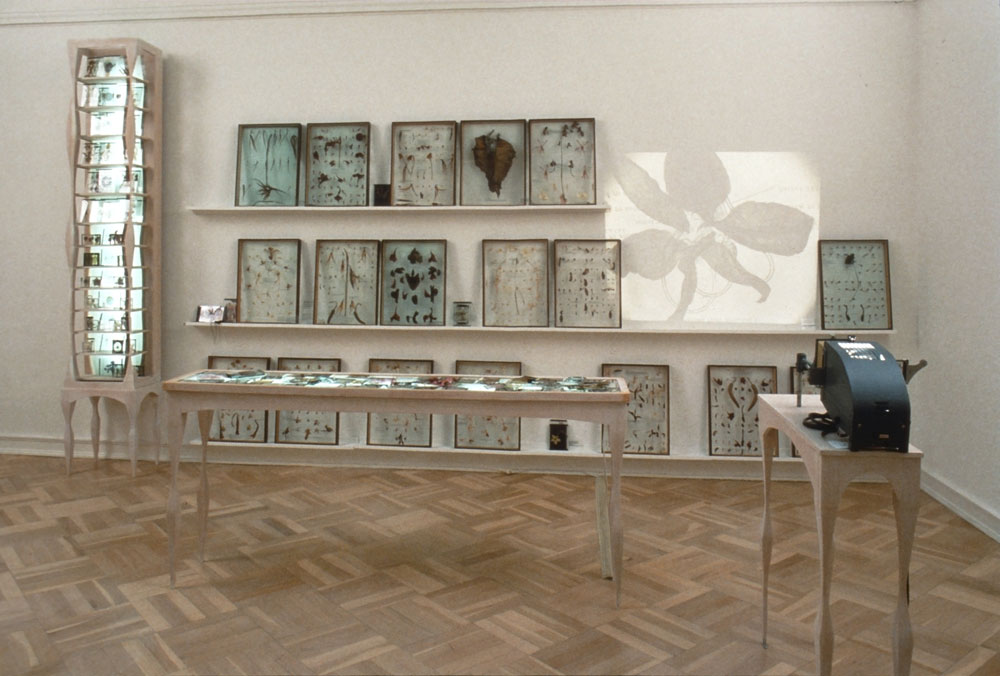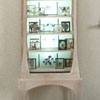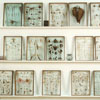Collectors Chamber
Art Gym, Marylhurst College [now Marylhurst University], Marylhurst, Oregon 1995
WORK IN EXHIBITION
COLLECTORS CHAMBER, INSTALLATION
Wood handmade cabinet wood tables holding glass slides, wood cases with dried plants. Space-10’x 20’x 20’
EXAMINATION TABLE
Vertical grain fir, with slides and magnifying glasses
7’x 40” x 18” table with slide projector--vertical grain fir
2’x 3’x18”
CABINET
Vertical grain fir, glass, fluorescent lights, 10’ x 24”
SHELVES
Vertical grain fir, 10’
18 CASES OF ORCHIDS AND TROPICAL FLOWERS
Vertical grain fir, glass, dried plants from Southeast Asia, 18” x 20”
DESCRIPTION
The tall cabinet structure with the subtle curvature of a female human’s body, has a single spinal cord-like fluorescent tube running down the center, illuminating the glass plates layered on the shelves, alluding to the body’s interior. Central in the installation is a tall examination table that allows the viewer to further inspect the plant material under magnifying glasses. Adjacent to this is a smaller table, holding a 4 x 5’ projector to enlarge the slides to a three-foot square that closely examines tissue as it dries. Lining the wall are shelves holding eighteen cases in which rare orchids and tropical flowers are pinned into patterns and documented with their translated Latin names. The graphics I used on the glass plates of medical charts, diagrams of female organs, and sound wave patterns point out our desire to label and order nature.
ARTIST’S STATEMENT
The Collectors Chambers, or “Wunderkammer”, refers to an Explorers Library in which nature’s bounty and exotic objects were housed. The tradition of such structures originated during the late Renaissance from the huge fortunes amassed by European capitalists on their “Voyages of Discovery”. The Wunderkammer is the European ancestor of our museums.
“Voyages of Discovery” caused the number of plants known by Europeans to quadruple between 1550 and 1700. Prior to this huge influx, botany was studied for medicinal and culinary purposes. The samples were organized alphabetically. With the expansion of the numbers of these botanical samples, a new, universal, organizing principle was needed. Carl von Linnaeus’ “Sexual System” was adopted in 1735 as such an organizing principle. This system gave no indication of the indigenous cultures’ knowledge of these plants. Each organism was fitted to a single hierarchy based on the plant’s sex. Linneaus’ system of binary nomenclature still serves as the basis of biological classification today.
Over the course of the last year, I have collected and observed a tremendous variety of exotic plants growing in the botany greenhouses at the University of Washington. As I collected these flowers, I became fascinated by the language used to identify and catalogue them and the traditional structures into which these precious and rare pieces of nature were placed. I have adopted this scientific language, and the cabinet structure as part of my visual language to exhibit my collection. The information I have provided is not meant as a linear cataloging of these samples but rather a reference to historical facts and scientific language.
I collected these flowers to learn more about their origins, to observe their strange and beautiful forms, to watch them decay, and to attempt to preserve them. The brief life of a flower made me acutely aware of the ephemeral nature of all things. I have enshrined these forms to capture them, to stop their decaying action, and to present them publicly.
The Chamber was originally fabricated in 1994 for the MFA thesis exhibition at the University of Washington and installed at the Henry Gallery. This work was continually worked on and reinstalled at Marylhurst University in 1995. In The 1997 Oregon Biennial, at the Portland Art Museum, the installation was awarded first prize. The piece also traveled to the Schneider Museum of Art (Ashland, Oregon), the University of Oregon Museum of Art (Eugene, Oregon), and the Willamette University Museum of Art, (Salem, Oregon).



